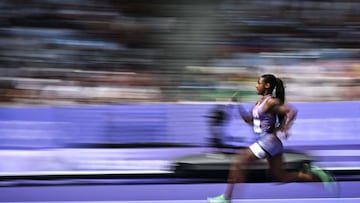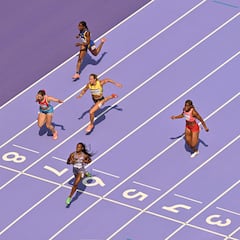What does SB mean in track and field? Athletics abbreviations at the 2024 Olympics in Paris
With all the abbreviations used in the competitions, watching track and field at the Olympics can be confusing.

The 20 km (12.4 miles) Olympic walk, held yesterday, August 1, began track and field competitions at the Paris 2024 Olympic Games. The Ecuadorian Daniel Pintado, in the men’s category, and the Chinese Jiayu Yang, in the female, were the first athletes to win a medal in this discipline.
Abbreviations are a common part of the sport, as seen during the competition and, in general, throughout everything leading up to the Paris Olympics. These can be used for different countries, post-event results, governing bodies, and athlete classifications.
Considering the country’s codes, these are taken from their French name, are generally the simplest to understand, and are displayed in the medal tables. For instance, the code for the United States is the USA; for Spain, it is ESP (Espagne in French), and for Switzerland is SUI (Suisse in French). The code EOR refers to the Olympic refugee team and is translated from the French Équipe Olympique des Réfugiés.
Possibly, the country code that has caused more confusion among fans is the one used for Russian and Belarusian athletes: AIN. This translates to Individual Neutral Athlete and is used for athletes invited to the games, such as Russia and Belarus.
When it comes to sports, all the abbreviations used can generate confusion for those who watch the games on TV, and athletics is no exception. But don’t worry, here we explain the abbreviations used in this sport.
Athletics abbreviations used at the Olympic Games
Possibly the most accessible terms to recognize are world record and Olympic record, represented by WR and OR, respectively. On the other hand, PB refers to personal best, while SB means season best, that is, the best mark obtained by an athlete within a given season.
Welcome to your 5th Olympic Games, icon 💜#Paris2024 pic.twitter.com/TizF4Bea2e
— World Athletics (@WorldAthletics) August 2, 2024
Another term in athletics is “Q,” which refers to participants who qualify for the next round/heat. It is important not to confuse it with “q,” which refers to the fact that although an athlete is classified, their pass depends on the results of competitors who haven’t yet competed.
You will see both an “X” and an “O” during jump events after the athlete competes. The first means a foul, while the second, used in the high jump, indicates that the athlete can advance to the next height. On the other hand, an “r” indicates an athlete who had to return from an event.
Related stories

Sha'Carri getting into gear

The Turkish sensation at the Paris Olympics
A disqualification is coded as DQ. DNS means athletes did not start in a specific event, while the code DNF translates to someone who started but did not finish. To denote events, CE means combined Events; DMR stands for distance medley race, DT for discuss throw, PV for pole vault, and HT for hammer throw, and these are almost self-explanatory.
Other codes used in athletics are: CR (Championship Record), ER (European Record), GR (Games Record), NR (National Record), AR (Area or Continental Record), NR (National Record), and DLR (Diamond League Record).
Complete your personal details to comment